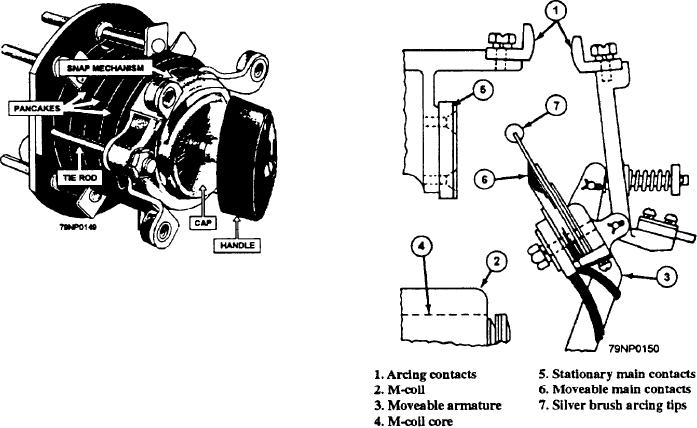
Figure 6-8.--Rotary snap switch.
Master switches may start a series of operations
when their contacts are either closed or opened. In a
momentary contact master switch, the contact is closed
(or opened) momentarily; it then returns to its original
condition. In the maintaining contact master switch, the
contact does not return to its original condition after
closing (or opening) until it is again actuated. The
Figure 6-9.--Detailed view of arcing contacts.
position of a normally open or normally closed contact
in a master switch is open or closed, respectively, when
The blowout shield has been removed in this detailed
the switch is de-energized. The de-energized condition
view. As you read this section refer to figure 6-9.
of a manual controller is considered to be in the OFF
position
The arcing contacts (1) are made of rolled copper
with a heavy protective coating of cadmium. These
contacts are self-cleaning because of the sliding or
CONTRACTORS
wiping action following the initial contact. The wiping
action keeps the surface bright and clean, and thus
Contractors are the heart of any controller. They
maintains a low contact resistance.
operate to open and close the contacts that energize and
de-energize connected loads.
The contactor is operated by connecting the coil (2)
directly across a source of dc voltage. When the coil is
DC Contractors
energized, the movable armature (3) is pulled toward the
stationary magnet core (4). This action causes the
A dc contactor is composed of an operating magnet
contacts that carry current (5, 6, 7, and 1) to close with
a sliding action
energized by either switches or relays, fixed contacts,
and moving contacts. It maybe used to handle the load
The main contacts (5 and 6), called brush contacts,
of an entire bus or a single circuit or device. Larger
are made of thin leaves of copper that are backed by
contacts must be used when heavy currents are to be
several layers of phosphor bronze spring metal. A silver
interrupted. These contacts must snap open or closed to
brush arcing tip (7) is attached to the copper leaves and
reduce contact arcing and burning. In addition to these,
makes contact slightly before the leaf contact closes.
other arc-quenching means are used.
The stationary contact (5) consists of a brass plate,
ARCING CONTACTS.-- The shunt contactor
which has a silver-plated surface. Since the plating
shown in figure 6-9 uses a second set of contacts (1) to
lowers the surface resistance, the contact surfaces
reduce the amount of arcing across the main contacts (5
should never be filed or oiled. If excessive current
and 6) when closing. The numbers that are in
causes high spots on the contact, the high places maybe
parentheses are indicated on the figure. Shunt-type
smoothed down by careful use of a fine ignition-type
contractors will handle up to 600 amperes at 230 volts.
file.
6-5

